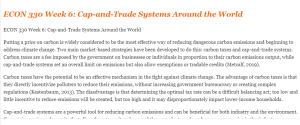ECON 330 Week 6: Cap-and-Trade Systems Around the World
ECON 330 Week 6 Cap-and-Trade Systems Around the World
Putting a price on carbon is widely considered to be the most effective way of reducing dangerous carbon emissions and beginning to address climate change. Two main market-based strategies have been developed to do this: carbon taxes and cap-and-trade systems. Carbon taxes are a fee imposed by the government on businesses or individuals in proportion to their carbon emissions output, while cap-and-trade systems set an overall limit on emissions but also allow exemptions or tradable credits (Metcalf, 2019).
Carbon taxes have the potential to be an effective mechanism in the fight against climate change. The advantage of carbon taxes is that they directly incentivize polluters to reduce their emissions, without increasing government bureaucracy or creating complex regulations (Kestenbaum, 2013). The disadvantage is that determining the optimal tax rate can be a difficult balancing act; too low and little incentive to reduce emissions will be created, but too high and it may disproportionately impact lower-income households.
Cap-and-trade systems are a powerful tool for reducing carbon emissions and can be beneficial for both industry and the environment. Companies are issued permits that allow them to emit carbon, and these can be transferred among companies in the industry on a carbon market. This allows businesses more flexibility to achieve the required reduction. The advantage of cap-and-trade systems is that the cap ensures that emissions are reduced to a certain level, and the market allows for flexibility in achieving the reduction. However, difficulty can arise in setting the initial allocations of permits, and this can create issues where some companies maintain an unfair advantage over others due to initial permit size. It is also possible for manipulation of the system to occur if certain entities acquire more permits than may have initially been planned. Despite these potential drawbacks, cap-and-trade systems remain an effective way of limiting carbon pollution while providing companies with incentives to reduce their emissions.
Economists favor market-based strategies like carbon taxes and cap-and-trade systems for superior cost-effectiveness and political viability. These techniques create financial incentives for companies to reduce emissions, in contrast with “command and control” methods like technology standards that require a mandated pollution control solution regardless of cost (Hu et al., 2020). Market-based solutions are typically more affordable to corporations as they can weigh their own needs while having some flexibility to adapt to changing requirements. From a political standpoint, they provide an even playing field where the government isn’t put in a position of picking certain economic entities over others.
In this assignment, I learned about two common market-based policy tools used to address negative externalities associated with

carbon emissions: Cap-and-trade systems and carbon taxes. Cap-and-trade systems involve setting a cap on total emissions and allowing firms to buy and sell emissions permits, while carbon taxes involve levying a tax on each unit of carbon emissions (Chen et al., 2020). Both policies aim to reduce emissions in a cost-effective way by incentivizing firms to reduce emissions through market mechanisms. While both policies have their advantages and disadvantages, I believe that a carbon tax could be more effective in reducing emissions, as it provides a clear and predictable price signal to firms, whereas cap-and-trade systems can be subject to market volatility. In my workplace or everyday life, I could apply the principles of market-based environmental policies to evaluate the effectiveness of different environmental policies and advocate for those that align with economic efficiency and sustainability goals.
ECON 330 Week 6: Cap-and-Trade Systems Around the World References
Chen, Y. H., Wang, C., Nie, P. Y., & Chen, Z. R. (2020). A clean innovation comparison between carbon tax and cap-and-trade system. Energy Strategy Reviews, 29, 100483. https://www.sciencedirect.com/science/article/pii/S2211467X20300365
Hu, X., Yang, Z., Sun, J., & Zhang, Y. (2020). Carbon tax or cap-and-trade: Which is more viable for Chinese remanufacturing industry?. Journal of Cleaner Production, 243, 118606. https://www.sciencedirect.com/science/article/abs/pii/S0959652619334766
Kestenbaum, D. (2013). Economists Have a One-Page Solution to Climate Change. NPR, http://www. npr. org/templates/transcript/transcript. php. https://www.npr.org/sections/money/2013/06/28/196355493/economists-have-a-one-page-solution-to-climate-change#:~:text=Climate%20change%20seems%20like%20this,the%20problem%3A%20Tax%20carbon%20emissions.
Metcalf, G. E. (2019). On the economics of a carbon tax for the United States. Brookings Papers on Economic Activity, 2019(1), 405-484. https://muse.jhu.edu/pub/11/article/740191/summary
Please note that if you edit your initial response (original post), you will not get credit for the original post. The discussions are set up as “Must post first.”
1. Read and listen to the following resources:
Economists Have a One-page Solution to Climate Change
Resources for the Future: Carbon Pricing Explainer
Gilbert Metcalf: On the Economics of a Carbon Tax for the United States (Read Section II only – though the first section is good as well)
2. Answer all of the following questions in your initial response to the topic:
Economists generally agree that putting a price on carbon is the best approach to reducing climate warming carbon emissions. The two main strategies for doing this are carbon taxes and the cap and trade version of emissions trading.
Discuss the pros and cons to these two approaches to pricing carbon.
Why do economists favor these kinds of market-based strategies to pollution control over “command and control” approaches such technology standards?
Reflection: Include a paragraph in the initial response in your own words using microeconomics terminology, reflecting specifically on what you learned from the assignment and how you think you could apply what you learned in the workplace or in everyday life.
Your answers should be written in your own words. Don’t use quotes from the articles.
You are expected to make your own contribution in a main topic as well as respond with value-added comments to at least two of your classmates as well as to your instructor.

